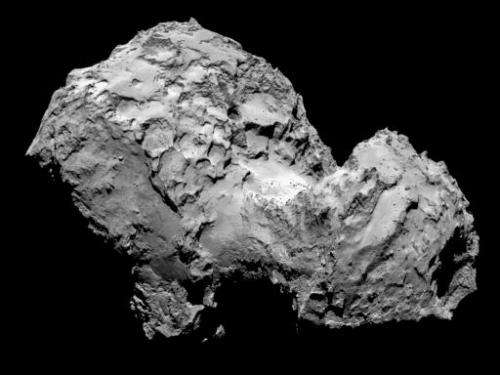'Eau de comet' is a bit of a stinker

Rotten eggs, horse pee, alcohol and bitter almonds: this is the bouquet of odours you would smell if a comet in deep space could be brought back to Earth, European scientists said on Thursday.
An instrument aboard the probe Rosetta has detected some intriguing chemical signatures from Comet 67P/Churyumov-Gerasimenko since their rendezvous in deep space in August, they said.
Molecules include ammonia, methane, hydrogen sulphide, hydrogen cyanide and formaldehyde.
"If you could smell the comet, you probably wish that you hadn't," the team said wryly in a blog posted on the European Space Agency (ESA) website.
The device, called Rosina-DFMS, is a mass spectrometer—it has been analysing the signature of gas given off by the "coma," the comet's head, as the distance closes with the Sun.
"The perfume of 67P/C-G is quite strong, with the odour of rotten eggs (hydrogen sulphide), horse stable (ammonia) and the pungent, suffocating odour of formaldehyde," said Kathrin Altwegg, Rosina's chief scientist.
"This is mixed with the faint, bitter, almond-like aroma of hydrogen cyanide.
"Add some whiff of alcohol (methanol) to this mixutre, paired with the vinegar-like aroma of sulphur dioxide and a hint of the sweet aromatic scent of carbon disulphide, and you arrive at the 'perfume' of our comet."
The detection of so many different molecules at this stage has been a surprise, ESA said.
The Rosina team believed only the most volatile molecules—carbon dioxide and carbon monoxide—would be released as the comet's icy surface started slowly to warm.
On a 6.5-year orbit, 67P/C-G is the target of an ambitious mission to shed light on the origins of comets, ancient travellers of the Solar System.
Rosetta caught up with it after a six-billion-kilometre (3.75-billion-mile) trek that required four flybys of Earth and Mars, using the planets' gravity as a slingshot to build up speed.
It is now in close orbit around the comet at a distance of around 400 million kilometres from the Sun. The scout will send down a robot lander, Philae, on November 12 to carry out on-the-spot scientific tests.
On August 13 next year, the comet and Rosetta will be 185 million kilometres from the Sun, their closest approach to our star.
© 2014 AFP



















